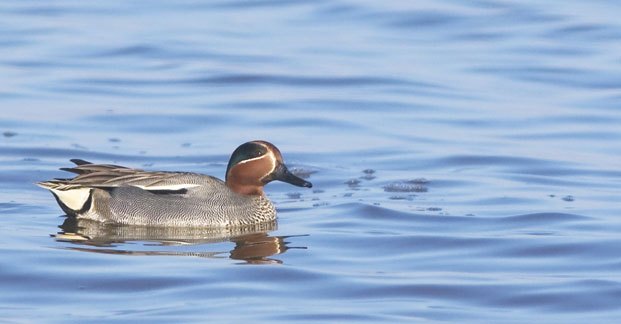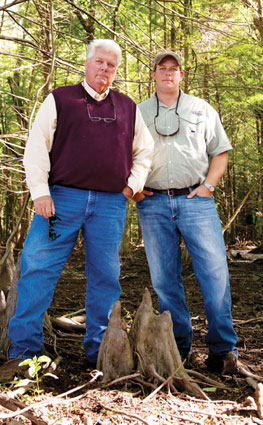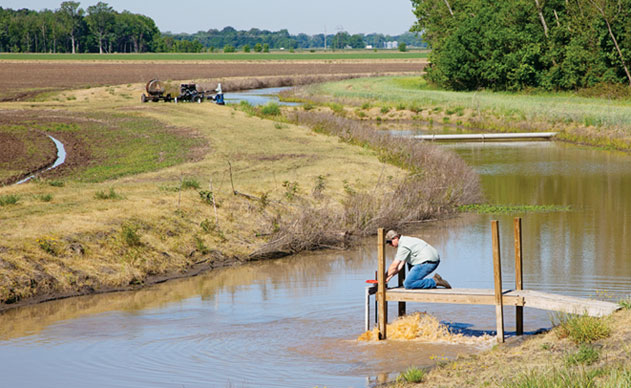
For a duck hunter, there’s no better place in December and January than Beaver Dam Lake. Formed from an oxbow in the Mississippi River ages ago, it was made famous by the stories of Memphis outdoor writer Nash Buckingham early in the 20th century.
Now there’s another storyteller on the lake. Mike Boyd spends 60 days every winter guiding hunts there with his son, Lamar, through his business, Beaver Dam Hunting Services. A few lucky people come to Tunica County, Miss., from all over the United States to hunt from blinds tucked into the cypresses and to be entertained by Mike’s wit and Lamar’s hospitality.
Even when they’re farming the other 305 days of the year, waterfowl are never far from the Boyds’ minds. That’s why an opportunity on their favorite tract spoke to them clearly.
Less than two miles east of Beaver Dam Lake, as the duck flies, is the land they call the Dockery place. If you were a bird, you’d eye the cover of a huge wooded wetland there and the food in the adjacent fields of crops. If you were a farmer, you’d admire the sandy loam soil found at this midpoint in the Mississippi Delta. But whether farmer or fowl, you’d have a new reason to be curious: Millions of gallons of rainwater and nutrient-rich irrigation runoff, or tailwater, are collected and stored on the farm for irrigation.
A Lifelong Love of the Land
Mike Boyd has worked 500 acres of the Dockery place all his life, just as his father and grandfather did, and his son joined him after graduating from Mississippi State University in 2008. They love the property’s other 375 acres, too, part of a vast slough filled with cypress trees and wildlife.
“My family rented it one year at a time. There’s no telling how many times we’ve bought it in rent,” says Mike. He also farms on family-owned land in Tunica County, and he offered to buy the Dockery place several times.
Finally, in 2008, he got lucky. He was able to buy the land from the grandchildren of the late owner, Keith Dockery McLean, who had instructed heirs to sell the land and give Mike Boyd right of first refusal.
“It’s one of the best things I ever did in my life,” Mike says. “I’d always wanted that place, and I never dreamed I’d be able to buy it.”
The land had wonderful soil, but pockets of trees and rolling terrain limited his crop and irrigation options. Once it was his, it made sense to precision-level the property.
That’s when the Boyds discovered that including a tailwater recovery system with on-farm storage would not only reduce their out-of-pocket costs for land forming, but also provide a home for waterfowl and keep sediment out of their beloved Beaver Dam Lake.
“It was win-win,” Mike says.
Tailwater for Food and Fowl
It was a soil conservation technician with the Natural Resources Conservation Service (NRCS) who first suggested that the Boyds try tailwater recovery. A duck hunter himself, Brad Mitchell knew that it would benefit waterfowl and the environment.
“That place was irrigated, but it wasn’t land-formed,” Mitchell says. “The water was running off-site. Nothing was being captured to be reused.”
Most Delta farmers are interested in land forming, but precision grading alone is not enough to qualify for financial assistance, says Paul Rodrigue, an NRCS supervisory engineer in Grenada, Miss.
“We provide incentives to introduce the next level of conservation,” says Rodrigue, who designed the Boyds’ project. “With tailwater recovery, you get land forming, and also water conservation, water quality and energy conservation across the board. We can attack several problems with one set of practices.”
“The NRCS staff will fine-tune your plan and suggest aspects that you would not otherwise know about,” Lamar says of the process. “That will increase your chances of getting funded.”

When they aren’t farming in the Mississippi Delta, father and son Mike and Lamar Boyd guide winter duck hunts. That’s one reason they love the land they call the Dockery place, which has room to farm, plus large cypress-filled sloughs that attract waterfowl. A new system that stores and reuses runoff for irrigation has started to attract even more ducks. Debra Ferguson/Southern Images
Tailwater for Food and Fowl
It was a soil conservation technician with the Natural Resources Conservation Service (NRCS) who first suggested that the Boyds try tailwater recovery. A duck hunter himself, Brad Mitchell knew that it would benefit waterfowl and the environment.
“That place was irrigated, but it wasn’t land-formed,” Mitchell says. “The water was running off-site. Nothing was being captured to be reused.”
Most Delta farmers are interested in land forming, but precision grading alone is not enough to qualify for financial assistance, says Paul Rodrigue, an NRCS supervisory engineer in Grenada, Miss.
“We provide incentives to introduce the next level of conservation,” says Rodrigue, who designed the Boyds’ project. “With tailwater recovery, you get land forming, and also water conservation, water quality and energy conservation across the board. We can attack several problems with one set of practices.”
“The NRCS staff will fine-tune your plan and suggest aspects that you would not otherwise know about,” Lamar says of the process. “That will increase your chances of getting funded.”
Creating a Waterfowl Paradise
Because Lamar, now 27, had been farming for less than 10 years, he qualified for as much as 20 percent more funding than his father, says Chantel Davis, who heads the Tunica NRCS office. Together, father and son offset much of the cost to level the land, excavate a reservoir and ditch, and install pumps and underground pipes.
After 18 months of planning and five months of land forming that moved 700 to 1,000 cubic yards of soil per acre, last year the Dockery place had 10 fields averaging 40 acres apiece. For uniform irrigation, fields are graded to drop about 1.8 feet over a typical 1,200-foot row length and are surrounded by levees called pads.
Supplying water for furrow irrigation is a new 9-acre reservoir and a 2-mile-long, 30-foot-wide ditch. To fill them, the Boyds blocked drain pipes and let the rain form ponds in their fields last winter, creating a seasonal home for ducks and geese in the process. They then pumped 12 million gallons from the fields into the reservoir and ditch, and can also divert water into two large cypress breaks, which act as additional reservoirs and as wildlife habitat.
“We’re just making a waterfowl paradise,” Mike says.
The Boyds see potential for hunting at the Dockery place after the birds have had a few years to get established. That would let them provide a different kind of experience from Beaver Dam Lake, which only requires a short walk and a boat ride to a blind.
“It’s so pretty,” Mike says of hunting on the lake. “It’s kind of like sitting in church. You don’t have to do anything except stand up when I tell you to shoot.”
“This place is a little more wild,” he says.

A ditch that curves between the cypress break and the newly leveled cropland conveys water between the fields and the storage reservoir. Lamar Boyd works a valve to irrigate the field across the ditch. Debra Ferguson/Southern Images
Financing Starts Paying Off
Mike estimates that NRCS funding covered about 60 percent of the project’s cost. To make up the difference, he turned to Mississippi Land Bank, which had provided financing when he bought the land in 2008.
“Mississippi Land Bank saw the increase in the value of the land, and there was never any doubt that this was the thing to do,” Mike says.
“It’s something he’s doing for the future,” says his daughter, Claire Pegram, who joined the financing cooperative three years ago and is now its controller. “He’s farmed with his dad and granddad, and he knows you need to take care of the land.”
Bobby Spinks, vice president of branch lending at the Clarksdale branch, says that for land forming and irrigation installation, the co-op typically offers a line of credit that converts to a 10- or 15-year loan once the project is finished. The payback starts immediately, with more consistent yields and the ability to grow a wider variety of crops.
“It’s a great risk mitigator. And most of the time, you gain a dollar in land value for every dollar you invest in land forming,” Spinks says. “Now the Dockery place is as slick a farm as you can get around here.”
With corn and soybeans in their newly formed fields, Mike and Lamar are irrigating for the first time using the surface water they collected. Their reservoir could irrigate more than 140 acres, but they’re experimenting on just one 40-acre field this year and comparing yields with another that will use groundwater.
“We’re still learning how to drive this thing,” he says. “We’ve got everything on that farm, conservation-wise, that you could want. It’s about as environmentally friendly as you can get.”
He and Lamar say they already have seen a big decrease in their fuel usage compared with pumping groundwater. They’re also proud that they will minimize the soil erosion that was common with older farming practices, which Mike says has visibly added to the silt in Beaver Dam Lake in his lifetime.
And that’s all the more reason to love the Dockery place.
“It might not be the biggest farm in Tunica County, but as far as what it offers, it’s got it all,” says Mike.
– Staff
A Tailwater Primer
A tailwater recovery system is part of a three-tier approach to conserving water and energy and improving water quality, says Paul Rodrigue, the NRCS supervisory engineer in Grenada, Miss., who designed Mike and Lamar Boyd’s system.
Pads and pipes: Low dikes called pads are built around fields, covering drainage pipes that let water flow on or off the fields. Fields are graded for uniform irrigation, and pipes can be blocked to flood fields with rainwater and provide temporary habitat for waterfowl.
Tailwater recovery: About 30 percent of tailwater, or irrigation water that has not been absorbed, can be recovered and reused.
On-farm storage: Tailwater and rainwater can be collected in a reservoir and reused for irrigation.
PROS:
- Land leveling and tailwater recovery increase cropland values and rental rates.
- A well-designed tailwater recovery system reduces the need for groundwater by 25 percent, or by 75 percent with on-farm
- Pumping water to and from a reservoir uses 60 percent less energy than pumping groundwater.
- On-farm storage reduces runoff by 50 percent, keeping more nutrients and topsoil on the land.
- Reducing nutrient runoff can ease hypoxia, low oxygen levels that have created a 7,000-square-mile “dead zone” in the Gulf of Mexico devoid of fish and shrimp.
- Such conservation practices qualify for financial assistance from government agencies.
CONS:
- For every 16 acres a farmer wants to irrigate, he has to give up an acre to a reservoir.
- The ability to collect and store rainwater might be limited on some tracts.
- Land forming requires an up-front investment of $1 or more per cubic yard of soil moved, at 300 or more cubic yards per acre. The costs for pumps and pipe are comparable to other irrigation systems.